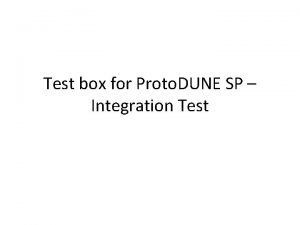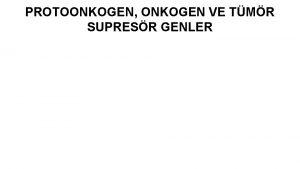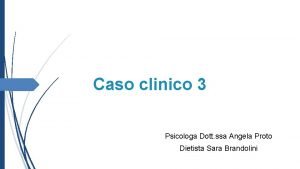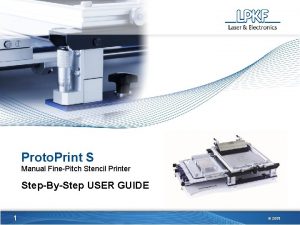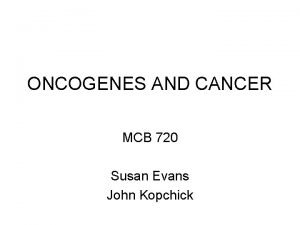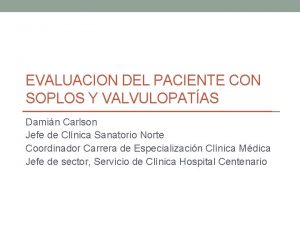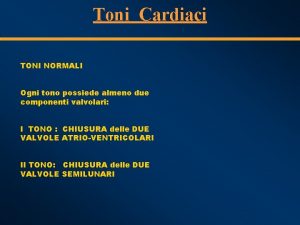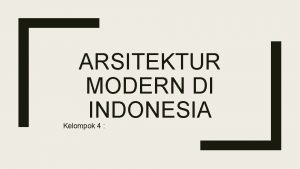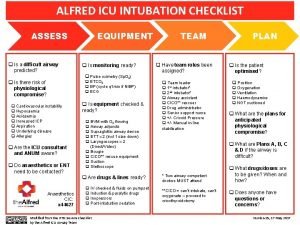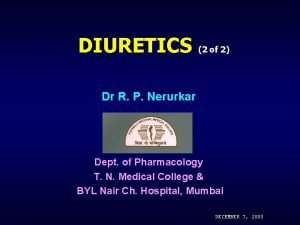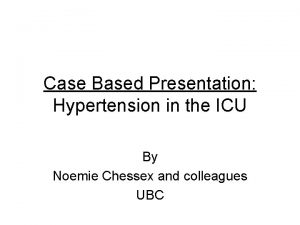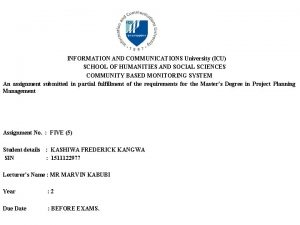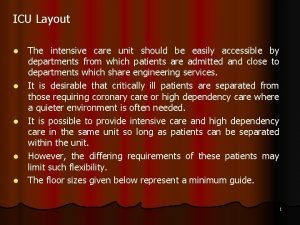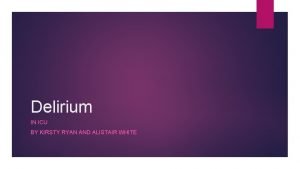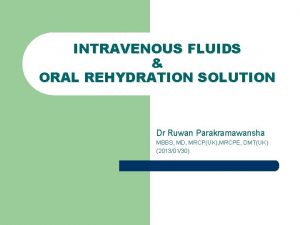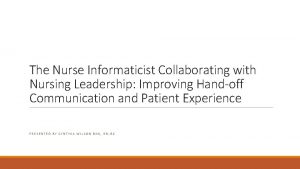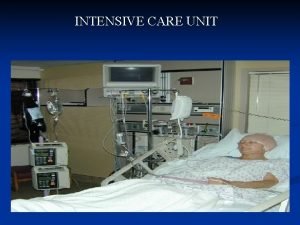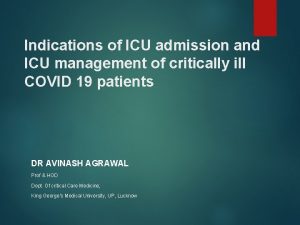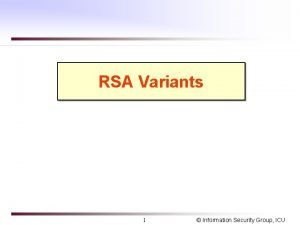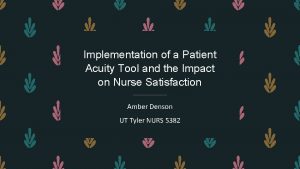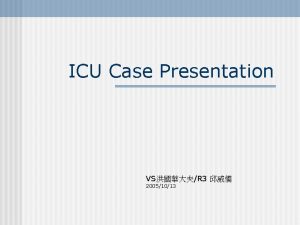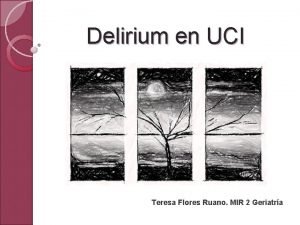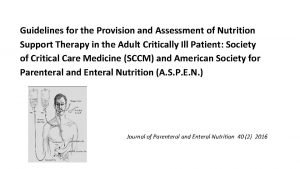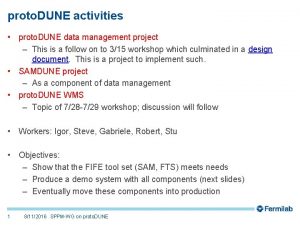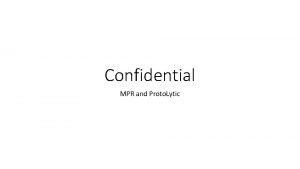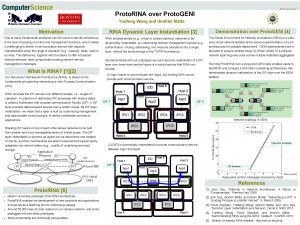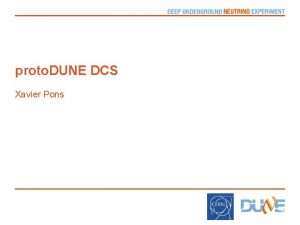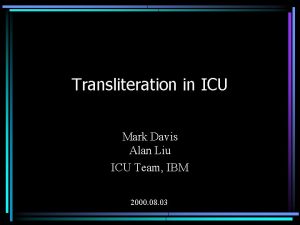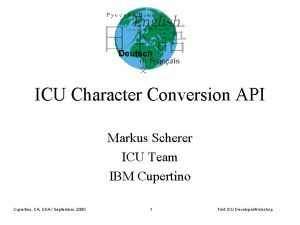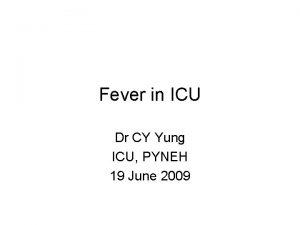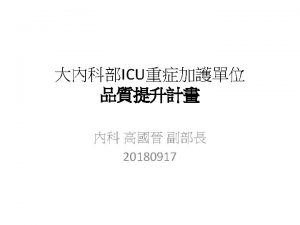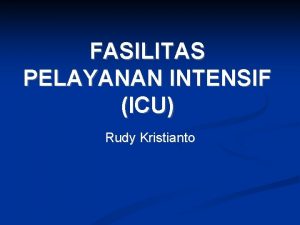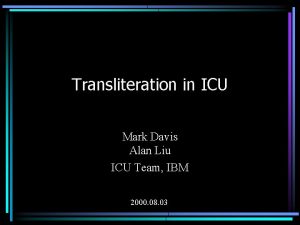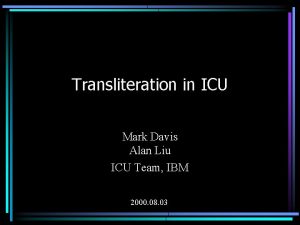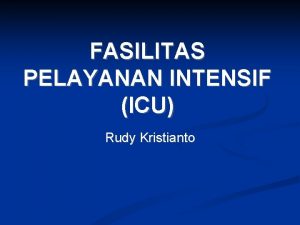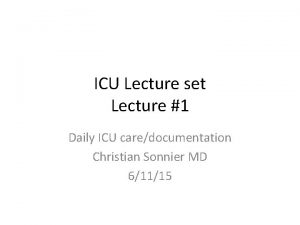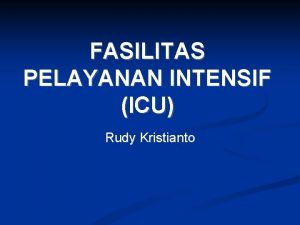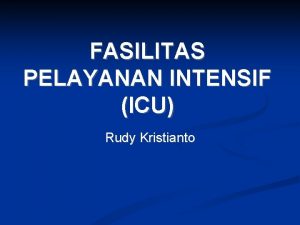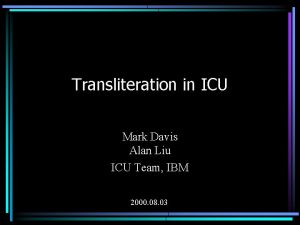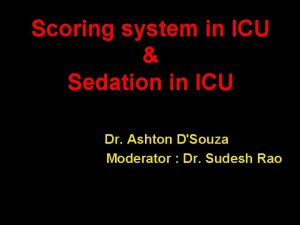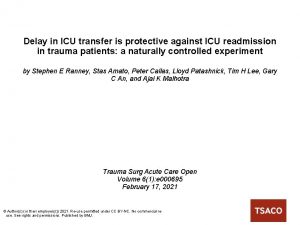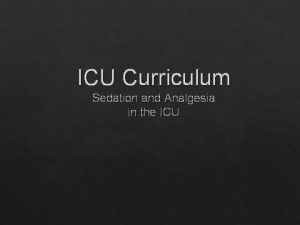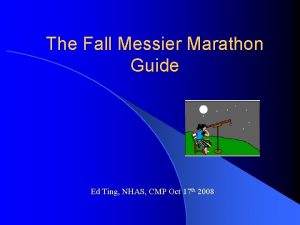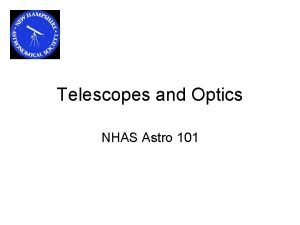ICU PROTO COLS Dr Vitul Ma nhas Dr












































- Slides: 44

ICU PROTO COLS Dr Vitul Ma nhas Dr R K Dogr a Dr Yashwan t Verma

SEQUENCE OF EVENTS FOR ANY CRITICALLY ILL PATIENT 0 Initial assessment 0 Transportation and shifting 0 Monitoring 0 Investigations 0 Infection control and treatment 0 Ventilatory support 0 Feeding and glycaemic control 0 Organ support 0 Supportive care 0 Progress of disease 0 Weaning 0 Discharge from ICU

Outreach calling criteria 0 Respiratory rate >25 or < 8/ min 0 Oxygen saturation < 90 % on Fi. O 2 > 0. 35 0 Heart rate > 125 or < 50 beats/min 0 Systolic blood pressure < 90 or > 200 mm. Hg 0 Sustained alteration in conscious level

Critical care level of dependency 0 Level 0 – require admission, monitoring < 4 hrs 0 Level 1 – risk of condition deterioration, monitor > 4 hrs 0 Level 2 – require single organ monitoring HDU, CCU 0 Level 3 – require advanced respiratory monitoring or support ICU Advanced respiratory monitoring or support Support for two or more organ system

Level 2 0 Inotropic support for cardiovascular monitoring 0 Renal replacement therapy 0 Non – invasive ventilatory support 0 Patient with major uncorrected physiological abnormalities 0 ASA grade III and ASA grade IV following major or minor surgery 0 Patient requiring pre – operative optimisation but not post – operative ventilation 0 Patient requiring frequent tracheal suctioning from tracheostomy tube 0 For rapid blood transfusion

Patients who are generally not appropriate for ICU admission 0 Irreversible brain damage 0 End stage cardiac, respiratory and liver disease with no options for transplant 0 Metastatic cancer unresponsive to chemotherapy and/or radiotherapy 0 Brain dead non-organ donors 0 Patients with non-traumatic coma leading to a persistent vegetative state

Brain stem dead testing 0 Pupillary light reflex 0 Corneal reflex 0 Pain response 0 Vestibulo-ocular reflxes 0 Gag or cough reflexes 0 Apnoea test

Transport of critically ill

Transport preparation ( ACCEPT) ASSESSMENT Full patient history and current problem CONTROL Identify leader and allocate tasks COMMUNICATION All communication is clear. Source identified and involve staff involved with patient dispatch and receipt. EVALUATION Assess risk and benefit of transport, equipment needed and urgency PREPARATION AND PACKAGING Prepare patient, equipment and staff TRANSPORTATION Transportation

Monitoring in ICU 0 Haemodynamic monitoring 0 Vital parameters, 0 Urine output 0 Neurological function 0 Peripheral circulation 0 Equipment functions and settings 0 Patient condition for progress or deterioration

Ensuring Accuracy 0 Appropriate measurement equipment for the size or age of the patient, e. g. BP Cuff 0 Correct siting of line, cuff 0 Phlebostatic axis or Zero point as reference point –Correlate zero point of the patient with that of transducer –Changing position of transducer with that of patient 0 Therefore importance of a spirit level 0 Calibration or standardization –zeroing to atmosphere

Assessment Patient Monitoring Equipment 0 Evaluate alarm defaults and configurations 0 Determine who is responsible 0 Develop checklist to guide such assessment 0 Presence of other equipment of importance; e. g. patient call lights 0 All alarms should be activated and assessed

Assessment of progress of disease Critical care scoring system 0 Glasgow coma scale – used universally 0 APACHE – USA & UK 0 SAPS – mainland europe 0 TISS 0 So. PRA 0 SOFA score 0 MODS score 0 Trauma score

SOFA SCORE 0 APACHE & SAPS scoring systems are designed and validated for data obtained during first 24 hrs of intensive care admission. 0 Sofa system has been used to prognosticate and to follow changes in patient status throughout there intensive care stay.

0 1 2 3 4 Respiratory Pa. O 2 : Fi. O 2 (mm. Hg) >400 <300 <200 <100 Renal Creatinine (mg/dl) U/O ( ml/d) <1. 2 -1. 9 2. 0 -3. 4 -4. 9 or <500 ml/d >5. 0 or <200 ml/d Hepatic Bilirubin (mg/dl) <1. 2 -1. 9 2. 0 -5. 9 6. 0 -11. 9 12. 0 Cardiovascular MAP(mm. Hg) N >70 Dopa <5 mcg Dopa>5 Or Dobuta Or adr<0. 1 any dose Dopa > 15 Or adr >0. 1 Haematological Platelet count(103/mm 3) >150 <100 <50 <20 Neurological GCS 15 13 -14 10 -12 6 -9 <6

INVESTIGATIONS AND MICROBIOLOGICAL SURVEILLANCE 0 0 0 Basic investigations on admission Full blood count (includes haemoglobin, total white and differential counts, platelet count) Serum creatinine, blood urea and electrolytes (including Na+, K+, Cl-, Ca 2+, Mg 2+, Phosphate 3 -) Liver function test Arterial blood gas Blood glucose level (hand held blood glucose analyser is acceptable) Septic / microbiology screen as indicated CXR (after placement of appropriate lines e. g. central venous line, nasogastric tube) Patients requiring post-operative ventilation for a few hours may not require a routine CXR ECG

Infection control 0 Hand Hygiene: 0 Use 60 – 90% alcohol or 0. 5 -1. 0% chlorhexidine (w/v) Airway orotracheal 0 Oral Hygiene – chlorhexidine 2% or povidone 10% at least thrice a day 0 Ventilator Circuits – change if visibly contaminated 0 Suction - no difference between closed and open 0 Body Position – 30 o – 45 o Head of Bed up (not just the head of patent as a sedated patient will slip down)

Skin prep 0 2% w/v chlorhexidine is better than 10% w/v povidone; chlorhexidine povidone and chlorhexodine sequential cleaning is even better as skin preparation for central line insertion. 0 Chlorhexidine 1% v/v is equivalent to only 1/5 of w/v solution. 0 Chlorhexidine 2. 5 % v/v is equivalent to only to a 0. 5% w/v solution – inadequate for skin preparation, but adequate for hand hygiene

Sepsis Resuscitation Bundle: 0 Serum lactate to be measured 0 Blood cultures obtained prior to antibiotic administration 0 From the time of presentation, broad-spectrum antibiotics administered within 3 hours for 0 Emergency Department admissions and 1 hour for non-ED ICU admissions 0 In the event of hypotension and/or lactate > 4 mmol/L (36 mg/dl): 0 Deliver an initial minimum of 20 ml / kg of crystalloid (or colloid equivalent).

0 Use vasopressors for hypotension not responding to initial fluid resuscitation to maintain mean arterial pressure (MAP) > 65 mm Hg 0 In the event of persistent hypotension despite fluid resuscitation (septic shock) and/or lactate > 4 mmol/L (36 mg/dl): 0 Achieve central venous pressure of 8 mm Hg 0 Achieve central venous oxygen saturation of > 70%

Sepsis Management Bundle: 0 Low dose steroid administered for septic shock in accordance with a standardized ICU policy 0 Dotrecogin alfa (activated) administered in accordance with a standardized ICU policy 0 Glucose control maintained > lower limit of normal, but < 150 mg/dl (8. 3 mmol/L) 0 Inspiratory plateau pressure maintained < 30 cm H 2 O for mechanically ventilated patients

The Antibiotic Care Bundle 0 0 0 0 Clinical criteria for initiation of antimicrobial therapy Actively get specimens for microbiology Initial empiric antibiotic choice based on local policy Remove infected source: foreign body, drain collections Modify when microbiology results are available Daily review of antibiotic choice and continuation. Regular expert input

What system of ICU care is best? 0 Closed unit - consultant intensivist. 0 Open ICU – primary consultant. 0 Semi closed or Transitional unit.

RECOMMENDATIONS DEFINING THE FUNCTIONS, ROLE AND RESPONSIBILITIES OF THE CONSULTANT INTENSIVIST

Admissions to and discharges from the ICU 0 The consultant intensivist is ideally placed to triage patients, prioritise admissions and maintain a waiting list. 0 The presence of written protocols outlining how patient admissions will be prioritised is helpful. 0 When discharging a patient from the ICU, the consultant intensivist should be satisfied that the patient is suitable for transfer out of the ICU.

All patients admitted to the ICU must be seen by a consultant intensivist. 0 daily rounds on all ICU patients. 0 Make a clear plan for the next 12 -24 hours. 0 Common ICU procedures should be performed by the consultant intensivist or by personnel designated by the consultant intensivist under his / her supervision.

0 0 0 0 0 Communication with patients and their families End of life decisions Time Commitment to the ICU Privileges outside the ICU Follow-up of patients outside the ICU Maintaining standards of intensive care practice Administration Payments Teaching Research

Services outside the ICU 0 Management of patients in the high-dependency unit 0 Medical Emergency Team: 0 Emergency department, including the Trauma team 0 CPR team 0 Artificial airway management 0 Invasive procedures outside the ICU (e. g. , Central Line, PICC lines, Lumbar puncture, Insertion of feeding tubes etc)

TRIAGE Due to the limited number of ICU beds, triaging may be necessary. The following factors will be taken into consideration in triaging: 0 Diagnosis 0 Severity of illness 0 Age and functional status 0 Co-morbid disease 0 Physiological reserve 0 Prognosis 0 Availability of suitable treatment 0 Response to treatment to date 0 Recent cardiopulmonary arrest 0 Anticipated quality of life

Discharge from the ICU 0 Conscious 0 Good airway, extubated and stable for several hours after extubation 0 Breathing comfortably 0 Stable blood pressure and urine output. 0 Haemoglobin >6 g/dl or blood transfusion in progress 0 Minimal nasogastric drainage and has bowel sounds, abdomen not distended 0 Afebrile 0 Looks better, sitting up, not confused.

FAST HUG Basic Bundle for all ICU patients A checklist: REMEMBER: FAST HUG 0 Feed 0 Analgesia 0 Sedation 0 Throboprophylaxis 0 Head of bed elevation 0 Ulcer prophylaxis 0 Glucose Control

CONTINUOUS INTRAVENOUS SEDATION 0 Patients are to be assessed for sedation and agitation based on the revised Riker Sedation and Agitation scale every 4 hours. The worst score within the last 4 hours is to be recorded. 0 Titrate the sedative infusion rate with the aim of keeping the sedation score between -1 to +1 0 Exceptions to keeping the sedation score between -1 and +1: a. head injured on cerebral protection: sedation score -3 b. severe sepsis on high inotropic support: sedation score of at least -1 c. RDS on high ventilatory support: sedation score of at least -2 d. tetanus: sedation score of at least -2

0 The standard sedative infusion to be used in patients admitted to ICU is midazolam and morphine. 30 mg midazolam and 30 mg morphine is diluted in up to 30 mls normal saline. The infusion may be started between 2 – 3 mls per hour 0 Fentanyl may be used instead of midazolam and morphine in the following conditions: a. renal failure b. hepatic failure 0 200 mcg Fentanyl is diluted in up to 20 mls normal saline. The infusion rate is between 2 - 5 mls per hour (20 50 mcg/hour) 0 Postoperative cases that are for overnight ventilation may be put on a. morphine + propofol b. dexmedetomidine (only for 24 hours) 0

0 Consider daily interruption of continuous sedative infusion at a fixed time every morning 0 If sedation score is +2, exclude other causes of agitation such as pain, hypoxia etc. Calm patient down by communicating with him. Increase the sedative infusion rate. 0 There may be a need to add further sedation For example: Tab. Lorazepam 1 -2 mg ON / bd Tab. Alprazolam 0. 5 mg bd / tds 0 If sedation score +3, exclude other causes of agitation. Bolus midazolam/morphine and increase infusion rate except in non ventilated patients. IV haloperidol will probably be indicated: 1. Age < 60 years: 5 -10 mg PRN / 4 -6 hourly 2. Age > 60 years: 2. 5 -5 mg PRN / 6 hourly

0 If sedation score: -2, half the intravenous sedative infusion. Decrease the sedative infusion every 4 hours until a score of -1 is achieved 0 If sedation score: -3, off sedative infusion. Assess 4 hours later. Restart at half the infusion rate once a score of -1 has been reached. 0 Patients that are paralysed need not be scored and should be denoted with a capital “P”

Revised Riker Sedation Agitation Scale Score Description defination +3 Agitated and restless When awaken or otherwise, pulling at ETT, trying to remove catheters or requires physical restraints +2 Awake but mildly agitated Anxious but mildly agitated. Attempts to sit up but calms down with verbal instructions +1 Awake and calm Awake, calm and easily follows commands 0 Aroused by voice and Awakens easily to verbal stimuli. Remains awake, calm remains calm and easily follows command -1 Aroused by movement Awakens to loud verbal stimuli or gentle shaking. Has eye contact for at least 10 seconds but drifts off to sleep OR Awakens to loud verbal stimuli or gentle shaking and follows simple commands -2 Aroused by painful stimuli Localising or flexion to pain. Does not communicate or follow commands -3 Unarousable Extension, minimal or no response to painful stimuli

STRESS RELATED MUCOSAL DISEASE PROPHYLAXIS IN THE INTENSIVE CARE UNIT Specific risk factors include : 0 mechanical ventilation ( more than 48 hours) 0 coagulopathy 0 shock states ( septic, haemorrhagic, cardiogenic, anaphylactic) 0 severe head injury and neurosurgical patients 0 severe burns ( more than 30%) 0 multiple organ failure

Prophylactic therapy for SRMD Considering available evidence and cost-effectiveness of current pharmacological agents for prophylaxis, the following are recommended: 0 IV Ranitidine 50 mg 8 hourly. Reduce dose to 50 mg 12 hourly in patients with renal failure. 0 The superior efficacy of intravenous H 2 antagonists compared with sucralfate in preventing SRMD has been demonstrated, and therefore, H 2 antagonists are preferred. 0 The use of proton pump inhibitors (PPI) as prophylaxis has not been shown to be superior to H 2 antagonists and should probably be limited to those with history of recent UGIB or recent endoscopically proven ulcer. 0 IV Omeprazole or IV Pantoprazole 40 mg daily

Discontinuing SRMD prophylaxis 0 Prophylactic therapy is discontinued once patient is on full feeds and none of the above risk factors are present. 0 Consider changing to oral therapy as soon as tolerating orally. 0 For those who develop clinically significant bleed in ICU, PPIs are continued for at least 2 weeks (IV / oral omeprazole or Pantoprazole 40 mg BD )

VENOUS THROMBOEMBOLISM PROPHYLAXIS RECOMMENDATIONS 0 On admission to the intensive care unit (ICU), all patients should be assessed for their risk of venous thromboembolism. 0 Consider withholding the heparin product when there is a significant decrease of platelet count (30 to 50% of initial count) or decrease to less than 100, 000 per micro liter of blood or when INR > 1. 5. 0 The prevention of VTE in neurosurgical has favoured mechanical prophylaxis methods. However the use of heparin products is considered to be safe after 48 to 72 hours.

0 The insertion and removal of epidural catheters should coincide with the nadir of the anticoagulant effect. The last dose of LMWH should be 12 hours prior to removal of catheter and can be restarted 2 hours later. 0 Routine screening of patients for asymptomatic deep vein thrombosis is not recommended since this strategy is neither effective nor cost-effective. 0 LMWH have a number of potential advantages over Low Dose unfractionated Heparin (LDUH) which include 1. once daily administration, greater bioavailability, lower incidence of heparin-induced thrombocytopenia and cost effective due to less laboratory monitoring 0 Early ambulation remains the most important non pharmacologic approach to prevention of VTE.

Pharmacological modalities 0 Low Dose unfractionated heparin (LDUH) eg. Subcutaneous (s/c) Heparin 5, 000 units 8 hourly (high risk) or 12 hourly (moderate risk) 0 Low molecular weight Heparin (LMWH) eg. S/C Enoxaparin (Clexane) 40 mg daily when creatinine clearance less than 30 ml/min or 30 mg daily when creatinine clearance greater than 30 ml/min

ABSOLUTE RISK FOR VTE Patient category Recommendations Low risk eg. medical patients, immobilization, use of pharmacologic paralysis or sedation, heart failure Mechanical prophylaxis Moderate risk eg. general surgery, major gynecologic surgery, major urologic surgery, sepsis, vasopressor use, active medical condition LMWH or s/c Heparin 5000 units 12 hourly in combination with mechanical prophylaxis High risk eg. stroke, neurosurgery, previous VTE LMWH or s/c Heparin 5000 units 8 hourly in combination with mechanical prophylaxis Highest risk eg. spinal cord injury, major trauma hip/knee arthroplasty, hip fracture Surgery LMWH in combination with mechanical prophylaxis

Thankyou
 Nhas training
Nhas training Mode con cols
Mode con cols Ng-html
Ng-html Proto renaissance art
Proto renaissance art Proto siva
Proto siva Proto oncogene
Proto oncogene Steven proto
Steven proto A proto odpouští má láska mému koni
A proto odpouští má láska mému koni Protoonkogen
Protoonkogen History of english language
History of english language Angela proto
Angela proto Part time jobs
Part time jobs Arti kata near pada sebuah kata nirleka adalah
Arti kata near pada sebuah kata nirleka adalah Proto print
Proto print Protoevangelium definition
Protoevangelium definition Oncogenes and tumor suppressor genes
Oncogenes and tumor suppressor genes Děti prošly smrkovým mlázím
Děti prošly smrkovým mlázím Proto barroco
Proto barroco Proto express
Proto express Soplo diastolico en apex
Soplo diastolico en apex Steven proto
Steven proto Vowel phonological processes
Vowel phonological processes Donatella proto
Donatella proto Proto meso tele
Proto meso tele Perkembangan arsitektur modern di indonesia
Perkembangan arsitektur modern di indonesia Holo proto meso tele
Holo proto meso tele Latin and romance languages
Latin and romance languages Alfred icu
Alfred icu Mannitol mechanism of action
Mannitol mechanism of action Icu case presentation
Icu case presentation List of lecturers at icu zambia
List of lecturers at icu zambia Icu layout and design
Icu layout and design Cam icu
Cam icu Normal saline uses
Normal saline uses Icu medical b3108
Icu medical b3108 Concept of intensive care unit
Concept of intensive care unit Rumus perhitungan tenaga perawat kamar operasi
Rumus perhitungan tenaga perawat kamar operasi 5hs and 5ts
5hs and 5ts Shanks algorithm example
Shanks algorithm example Icu acuity tool
Icu acuity tool Icu case presentation
Icu case presentation Cam icu escala
Cam icu escala Diet chart for icu patients
Diet chart for icu patients Icu unicode
Icu unicode Kp icu jpm
Kp icu jpm






